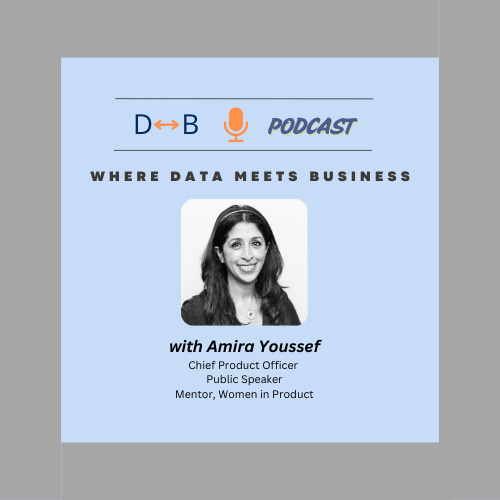Podcast Guest: Amira Youssef
Amira Youssef is a product executive and public speaker with over 20 years of global experience, specializing in AI, Cloud Technology, and digital transformation.
Currently a Chief Product Officer at a LegalTech AI SaaS Start-up, she is driving the development of a platform that creates a seamless marketplace to connect clients with attorneys.
Previously, at Microsoft, Amira led the growth of Azure Edge AI, creating a new product category and driving adoption across Fortune 500 companies through strategic partnerships with Nvidia and Intel.
She has mentored over 50 future leaders through Women in Product and regularly delivers keynotes on AI, leadership, and career development.
We covered topics including -
Understanding Product Vision
The Role of Customer Data
Connecting Data to Product Vision
Engaging Stakeholders with Customer Insights
The Impact of AI on Product Management
Women in Product
Some Highlights from the Episode
What is product vision
Product vision starts with articulating the problem that you are trying to solve.
Then you can work backwards to work out how you will bring that vision to life or develop the solution.
What data do you use to develop product vision?
You should triangulate data by taking a 360 degree approach and look at it through multiple lenses.
First, you need to meaningfully interact with customers first-hand, whether through meetings or research or usability testing.
Second, leverage any customer touch points in the product such as customer support issues, comments, reviews.
Third, look at behavioral data - how are customers engaging with your product, what are the usage patterns, how are churn and adoption?
Fourth, consider the competition and how your product is performing compared to the competitor’s and what are the market dynamics?
How do you identify signals in customer data?
Usage and churn are very strong indicators. Customers can tell you that they are satisfied but actual behaviors should be consistent with those reviews.
That is why triangulation is important as you draft the narrative on customer experience and why something is happening. That way you can hone in on whether it is an execution issue or it is just not meeting customer needs.
How is data utilized in existing products in larger organizations vs new products at startups?
For new products in startups, you follow the same steps for using data but it’s a more organic process with less use of frameworks. It’s more real time. You need to be agile.
In larger organizations, there is more planning, process and orchestration to using the data. It is also synched up with schedules or ‘semester planning’ and you need to influence and get approvals at the right moments to allocate resources.
How do you convince stakeholders about the value and use of customer data?
You have to give internal stakeholders confidence in the program. Inform them of the changes and give them a sense of ownership. You should always be transparent and include people in the process.
Does AI change how product vision is developed?
AI can help get you started. It makes it faster to develop the first version (v1) of your product.
It will free up time for people to work on more value-adding tasks.
But, you need to be mindful of how you use AI for understanding your data. You should question and critique it and not just accept it as-is.
Women in Product
A free organization which supports women in product through talks, events, networking and local chapters.
They run a ‘building career clarity’ program twice a year that you can participate in, among other opportunities.
References
Women in Product - a community to equip women and non-binary folks to thrive in product management careers at all levels







Share this post